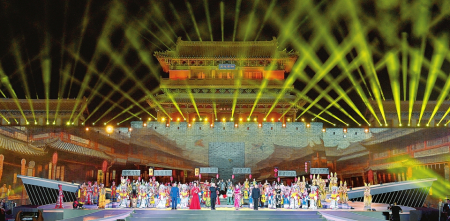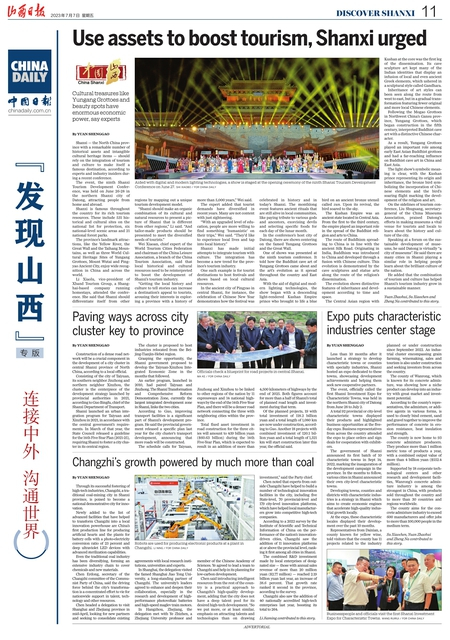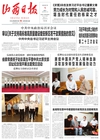Use assets to boost tourism, Shanxi urged

Aided with digital and modern lighting technologies, a show is staged at the opening ceremony of the ninth Shanxi Tourism Development Conference on June 27. Shi Xiaobo / For China Daily
Cultural treasures like Yungang Grottoes and beauty spots have enormous economic power, say experts
Shanxi — the North China province with a remarkable number of historical assets and intangible cultural heritage items — should rely on the integration of tourism and culture to make itself a famous destination, according to experts and industry insiders during a recent conference.
The event, the ninth Shanxi Tourism Development Conference, was held on June 26-28 in the northern Shanxi city of Datong, attracting people from home and abroad.
Shanxi is famous throughout the country for its rich tourism resources. These include 531 historical and cultural sites on the national list for protection, six national-level scenic areas and 21 national forest parks.
The province's landmark attractions, like the Yellow River, the Great Wall and the Taihang Mountains, as well as three World Cultural Heritage Sites of Yungang Grottoes, Mount Wutai and Pingyao Ancient City, enjoy wide recognition in China and across the world.
Li Xiaolu, vice-president of Xband Tourism Group, a Shanghai-based company running homestays, attended the conference. She said that Shanxi should differentiate itself from other regions by mapping out a unique tourism development model.
"Shanxi should make an organic combination of its cultural and natural resources to present a picture of Shanxi that is different from other regions," Li said. "And tailor-made products should be presented to meet the diversified needs of tourists."
Wei Xiaoan, chief expert of the World Tourism Cities Federation and chairman of the China Leisure Association, a branch of the China Tourism Association, said that local historical and cultural resources need to be reinterpreted to boost the development of Shanxi's tourism industry.
"Getting the local history and culture to tell stories can increase a destination's appeal to tourists, arousing their interests in exploring a province with a history of more than 5,000 years," Wei said.
The expert added that tourist demands have diversified in recent years. Many are not content with just sightseeing.
"With an upgraded level of education, people are more willing to find something 'humanistic' on their trips," Wei said. "They'd like to experience local lives and tap into local history."
Shanxi has made initial attempts to integrate tourism with culture. The integration has become a new trend for the province's tourism industry.
One such example is for tourist destinations to host festivals and shows based on local cultural resources.
In the ancient city of Pingyao in central Shanxi, for instance, the celebration of Chinese New Year demonstrates how the festival was celebrated in history and in today's Shanxi. The monthlong event features ancient rituals that are still alive in local communities, like paying tribute to various gods and ancestors, exorcising devils and selecting specific foods for each day of the lunar month.
In the conference's host city of Datong, there are shows centering on the famed Yungang Grottoes and the Great Wall.
One of shows was presented at the ninth tourism conference. It told how the Buddhist cave art of Yungang Grottoes came about and the art's evolution as it spread throughout the country and East Asia.
With the aid of digital and modern lighting technologies, the show began with a descending light-rendered Kushan Empire prince who brought to life a blue bird on an ancient bronze utensil called zun. Upon its revival, the bird soared to the sky13.
The Kushan Empire was an ancient state located in Central Asia. From the first to the third century, the empire played an important role in the spread of the Buddhist religion and arts to China.
The route of Buddhism spreading to China is in line with the ancient Silk Road. Originating in India, Buddhism was introduced to China and developed through a fusion with Chinese culture. This evolution is demonstrated by the cave sculptures and statue arts along the route of the religion's dissemination.
The evolution shows distinctive features of inheritance and development according to time and space.
The Central Asian region with Kushan at the core was the first leg of the dissemination. Its cave sculpture art kept many of the Indian identities that display an infusion of local and even ancient Greek elements, which ushered in a sculptural style called Gandhara.
Inheritance of art styles can been seen along the route from west to east, but in a gradual transformation featuring fewer original and more local Chinese elements.
Following the Mogao Grottoes in Northwest China's Gansu province, Yungang Grottoes, which began construction in the fifth century, interpreted Buddhist cave art with a distinctive Chinese character.
As a result, Yungang Grottoes played an important role among early East Asian Buddhist grottoes and had a far-reaching influence on Buddhist cave art in China and East Asia.
The light show's symbolic meaning is clear, with the Kushan prince representing its origin and inheritance, the bronze bird symbolizing the incorporation of Chinese elements and the bird's soaring flight marking the development of the religion and art.
On the sidelines of tourism conference, Liu Shuguang, secretary-general of the China Museums Association, praised Datong's efforts in making museums a vital venue for tourists and locals to learn about the history and culture of the city.
Speaking at a forum on the sustainable development of museums, he said Datong is virtually "a city of museums". He said there are many cities in Shanxi playing a similar role in helping people learn about the brilliant culture of the nation.
He added that the combination of tourism and culture has helped Shanxi's tourism industry grow in a sustainable manner.
Yuan Zhaohui, Su Xiaochen and Zheng Na contributed to this story.
By Yuan Shenggao











